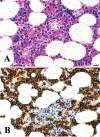Hairy cell leukemia diagnostic criteria and differential diagnosis
- PMID: 21417827
- PMCID: PMC6331060
- DOI: 10.3109/10428194.2011.565435
Hairy cell leukemia diagnostic criteria and differential diagnosis
Abstract
Hairy cell leukemia (HCL) is a disease with distinctive clinical findings, as well as a unique morphology and immunophenotype. These features typically allow for a reliable and reproducible diagnosis in nearly all situations. However, certain morphological features of HCL, such as villous cytoplasmic projections or characteristic tissue specific infiltrative patterns, including red pulp expansion with pseudosinuses, may be seen in other B-cell lymphoproliferative disorders. A methodical and thorough approach evaluating the clinical, cytological, histological, architectural, and immunophenotypic features is described and will aid in rendering the appropriate diagnosis. This is paramount as current data indicate that hairy cell leukemia - variant and other splenic B-cell lymphomas must be distinguished from HCL, as the response to therapy differs in these disorders.
Conflict of interest statement
Figures




References
-
- Swerdlow SH, Campo E, Harris NL, et al. WHO classification of tumours of haematopoietic and lymphoid tissues 4th ed. Lyon, France: IARC; 2008.
-
- Burthem J, Cawley JC. The bone marrow fibrosis of hairy-cell leukemia is caused by the synthesis and assembly of a fibronectin matrix by the hairy cells. Blood 1994;83:497–504. - PubMed
-
- Falini B, Tiacci E, Liso A, et al. Simple diagnostic assay for hairy cell leukaemia by immunocytochemical detection of annexin A1 (ANXA1). Lancet 2004;363:1869–1870. - PubMed
-
- Chen YH, Gao J, Fan G, Peterson LC. Nuclear expression of sox11 is highly associated with mantle cell lymphoma but is independent of t(11;14)(q13;q32) in non-mantle cell B-cell neoplasms. Mod Pathol 2010;23:105–112. - PubMed
-
- Nanba K, Soban EJ, Bowling MC, Berard CW. Splenic pseudosinuses and hepatic angiomatous lesions. Distinctive features of hairy cell leukemia. Am J Clin Pathol 1977;67:415–426. - PubMed
Publication types
MeSH terms
Grants and funding
LinkOut - more resources
Full Text Sources
